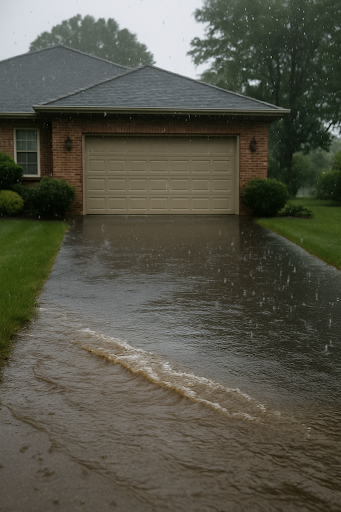Culvert Checkup: Replace That Failing Driveway Pipe Before the Next Big Storm
Early one Tuesday morning, a homeowner called in a panic: the end of their driveway had vanished into a chocolate-colored stream. Mailbox leaning, asphalt cracked, vehicles stuck. The culprit wasn’t the rain—it was a rusted, undersized culvert pipe that finally gave way.
Unfortunately, this scenario is all too common across Southeast Michigan. Heavier downpours paired with aging corrugated steel pipes lead to sinkholes, washouts, and township notices. If your driveway crosses a ditch, you have a culvert—yet many homeowners haven’t inspected it since moving in. Now’s the time to act.
What Actually Fails in a Culvert System
- Pipe Deterioration: Corrugated steel pipes corrode over time, losing their structural integrity.
- Erosion of Surrounding Soil: Water scours beneath the pipe, washing away gravel backfill and undermining the headwalls.
- Headwall and End Section Damage: Concrete or stone headwalls crack or crumble, causing flow disruptions.
- Debris Clogging & Collapse: Fallen branches, leaves, and sediment trap inside the barrel, leading to backups and bank overflow.
Early warning signs include sagging shoulder edges, persistent puddles at the inlet, sediment streaks on pavement, or a visibly deformed pipe end.
Why Townships Enforce Culvert Standards (and Why You Should Care)
The ditch alongside your driveway is part of a regulated drainage network. A clogged or collapsed culvert diverts water onto public roads or neighboring properties. When that happens, townships and road commissions can issue repair orders—and if ignored, the next storm may excavate your driveway for you (and bill you for repairs!).
A Proper Culvert Replacement: Step-by-Step
- Hydraulic Sizing & Specification
We calculate design storm flow or match township standards to select the correct diameter. A pipe that’s too small leads to repeated failures; one that’s too large can alter ditch hydraulics. - Material Selection
High-density polyethylene (HDPE) or reinforced concrete pipes last decades longer than galvanized steel. We choose materials based on site conditions and downstream erosion risk. - Utility Coordination & Permitting
We notify MISS DIG and coordinate with local road authorities if the culvert is within a right-of-way, securing any necessary permits before work begins. - Precision Excavation & Installation
Using GPS-guided equipment, we:- Excavate around the existing pipe and stockpile salvageable soil.
- Remove the failed pipe and headwalls.
- Set the new pipe on the engineered grade.
- Compact backfill in lifts around the barrel.
- Rebuild headwalls and shoulders, installing riprap or concrete end sections to prevent future scour.
- Final Site Restoration
We finish with clean, sharp edges, reseed disturbed areas, and use laser-guided grading to ensure water flows properly.
Why You Shouldn’t Wait Until Spring
Fall storms and early thaws cause the most damage. Frozen ground complicates excavation and restoration, driving up costs. Once snowplows push slush into your ditch, access becomes a hazard. If you’re already spotting pipe rust or pavement cracks, replacing your culvert now saves money and avoids winter headaches.
Why Thomas Excavation? We Stand Behind Our Work
- Immediate Response: We arrive with the correct pipe size preloaded, minimizing downtime.
- Advanced Technology: GPS and laser systems ensure precise grades and consistent flow lines.
- Comprehensive Service: From permits to riprap, we handle every step for a worry-free experience.
- Local Expertise: We understand the soils, weather impacts, and municipal requirements of Southeast Michigan.
Don’t risk a morning panic when the next storm hits. Call Thomas Excavation today for a free assessment. We’ll tell you straight: patch it, replace it, or rest easy for another season. One preventative visit now beats a washed-out driveway later.

